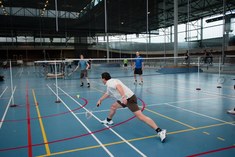Impact success story: Sports sciences
Children will like to do the sports they can do well, thought the developers of SportKompas. But that turned out to be completely false. How do you get a child hooked up with the right sport?
“When it comes to choosing a sport for their children, many parents struggle with the same problem,” says Matthieu Lenoir, Sports Science professor at Ghent University. “They sign their child up for a club, but after four months the child doesn’t think it’s fun anymore and quits. This is a big expense for parents, as well as for society.” There’s something else at play as well. “There’s a football field on every street corner in Flanders. This creates an unbalanced situation. Half of the children start with football and hardly anyone with korfball, just to give one example.” 
Matthieu Lenoir is the scientific director of SportKompas, an orientation tool that helps children between the ages of 8 and 10 to choose the right sport. “If you want to know if someone would be good at football, then people immediately think of dribbling tests and the like. But of course those who have already dribbled a lot score better. This therefore ignores the question of whether or not they are truly gifted. We don’t want to measure performance at a given time, but potential, innate talent.”
Looking for a suitable tool
The germ for the tool came about ten years ago when Ghent University scientists wanted to do something to get young people and children to participate in sports and develop their full potential. “People who exercise a lot during their first years of life are more likely to do so for the rest of their lives and derive a host of health benefits. Children who don’t have a greater risk of health problems.” So the scientists measured a lot of children. What can they do? What are their physical abilities? How is their coordination? On the basis of the results, profiles were drawn up for children of different ages and different levels of sports practice, from recreational athletes to competitive athletes and children who are already in a preliminary phase to later play at a professional top level.
Because the researchers wanted to serve many more children, the next question was how they could translate their research results into something that could be used by the general public. That became the job of Kristof De Mey, innovation and business developer at Victoris, a Ghent University consortium in the field of sports technology and innovation. “We took three years to work with researchers and other parties to see how we could configure the raw tool that we had available for each child.”
The team encountered some difficulties. There were some test materials, but they did not fit nicely together in a package. The branding and positioning also required some improvement. And there were financial hurdles to get past. Enter Bruno D’Hulster, an entrepreneur who was looking for a way to use his business talent for a social purpose. His role proved crucial for the further course of the story. Together with Kristof, he made an implementation plan to make SportKompas available to every child.
Kristof: “There was a first attempt, but no detailed plan, not even financial. Bruno drew one up.”
Ultimately, this is a good example of a project that would not have been possible without high-quality research, but that also needed people who could translate it into practice, in this case by establishing a non-profit association and implementing it within that structure.
No endpoint but a source for further research
In the meantime, Matthieu Lenoir continues his scientific research on the data that SportKompas provides. “SportKompas is no longer just about orientation to a sport. It’s much broader than that. It tackles issues of health, well-being and social integration. Ultimately, a child also gains confidence when they are successful at a sport. That’s why we’ve started to look at motivation. Why do children exercise or why not? What is feasible, what is their context?”
Bruno D’Hulster, now managing director of SportaMundi, the non-profit organisation behind SportKompas agrees: “We want to measure the effects of SportKompas by monitoring children for a longer period of time. By verifying whether they actually took up a recommended sport and whether they stay in it longer. By linking this back to the research team, new initiatives can be taken.”